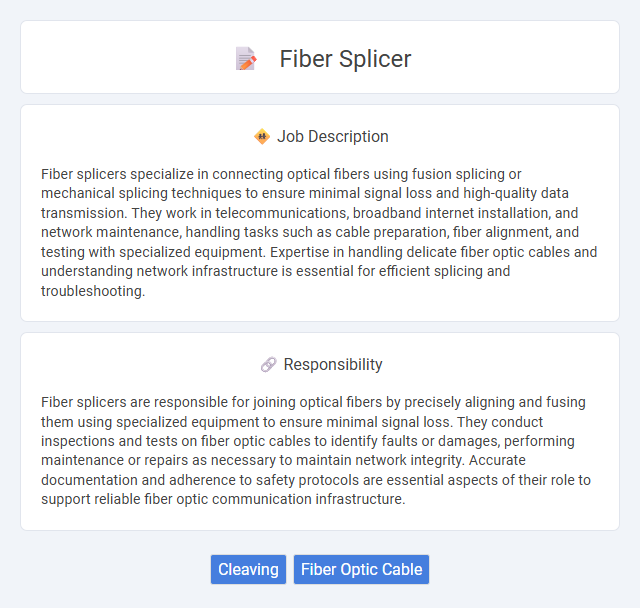
Fiber splicers specialize in connecting optical fibers using fusion splicing or mechanical splicing techniques to ensure minimal signal loss and high-quality data transmission. They work in telecommunications, broadband internet installation, and network maintenance, handling tasks such as cable preparation, fiber alignment, and testing with specialized equipment. Expertise in handling delicate fiber optic cables and understanding network infrastructure is essential for efficient splicing and troubleshooting.
Individuals with strong attention to detail and steady hand-eye coordination are likely to excel as fiber splicers, given the precision required to join delicate optical fibers. Those comfortable working in confined or elevated spaces and able to handle repetitive tasks under varying environmental conditions might find this job suitable. Physical stamina and patience could also increase the probability of success in this technical and often detail-oriented role.
Qualification
A fiber splicer must possess thorough knowledge of fiber optic cables, splicing techniques, and specialized equipment such as fusion splicers and optical time-domain reflectometers (OTDR). Certification from recognized organizations like the Fiber Optic Association (FOA) or equivalent technical training is essential to demonstrate expertise in fiber optic installation and maintenance. Strong attention to detail, manual dexterity, and the ability to interpret network diagrams ensure precise and reliable fiber optic connections critical for telecommunications infrastructure.
Responsibility
Fiber splicers are responsible for joining optical fibers by precisely aligning and fusing them using specialized equipment to ensure minimal signal loss. They conduct inspections and tests on fiber optic cables to identify faults or damages, performing maintenance or repairs as necessary to maintain network integrity. Accurate documentation and adherence to safety protocols are essential aspects of their role to support reliable fiber optic communication infrastructure.
Benefit
Fiber splicer jobs likely offer high demand in telecommunications and data infrastructure sectors, providing stable employment opportunities. Candidates may benefit from competitive salaries and specialized skills that can lead to career advancement. The role possibly includes hands-on technical experience and the chance to work on cutting-edge network projects, enhancing professional growth.
Challenge
Fiber splicer jobs likely present challenges including precise alignment of delicate optical fibers, which requires high levels of manual dexterity and attention to detail. Environmental factors such as working outdoors or in confined spaces may increase job complexity and demand adaptability. The probability of encountering unexpected technical issues necessitates problem-solving skills and continual learning.
Career Advancement
Fiber splicer jobs offer promising career advancement opportunities through skill development in fiber optic technology and network installation. Professionals can progress to roles such as lead splicer, project manager, or network technician by gaining certifications like FOA Certified Fiber Optic Technician. Continued education and experience enhance qualifications for higher-paying positions within telecommunications, data centers, and broadband service providers.
Key Terms
Cleaving
Fiber splicers achieve precise cleaving to ensure optimal fiber end-face alignment, critical for minimizing signal loss and reflection in optical fibers. Using high-quality cleavers, splicers create smooth, perpendicular fiber ends, enabling seamless fusion during splicing procedures. Accurate cleaving directly influences splice strength and network performance, making it a vital skill in fiber optic installation and maintenance.
Fiber Optic Cable
Fiber splicers specialize in joining fiber optic cables using precise fusion or mechanical splicing techniques to ensure minimal signal loss and optimal network performance. They work with high-tech equipment to align and fuse fiber cores, creating seamless connections essential for telecommunications, internet infrastructure, and data centers. Expertise in handling various cable types, understanding fiber optics principles, and adhering to industry standards guarantees reliable and efficient fiber optic networks.
 kuljobs.com
kuljobs.com